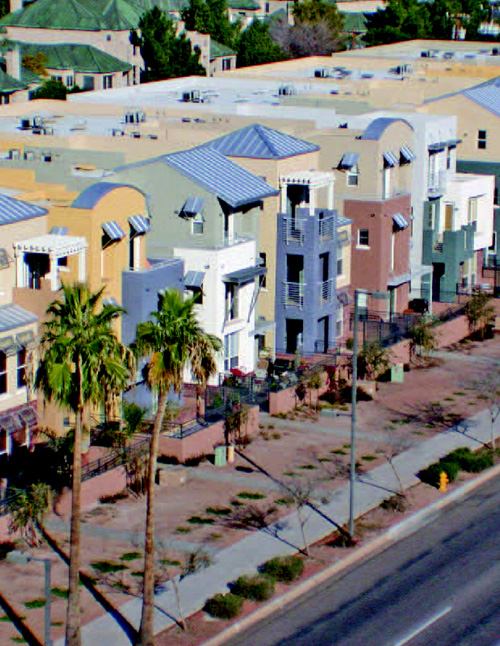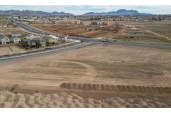PRIVATE, GATED COMMUNITIES HAVE LONG regulated house color, roof pitch, and the placement of the driveway. Their developers detail rigorously to attract buyers who are concerned with preserving property values and who can pay for a community with cachet. But in recent years, strict design regulations began to filter down to multiphase subdivisions from Tucson, Ariz., to Tallahassee, Fla. Now, hot housing markets and more sophisticated and diverse buyers are raising the bar on design irrevocably in many parts of the country, even on entry-level homes. In a backlash against certain suburban features that prevailed during the past two decades—formulaic elevations and boxy houses dominated by big garages—city planners and developers are going to new frontiers of design dictate. They demand streetscapes that fit in with a well-developed civic ethic and elevations that vary pleasingly from house to house and block to block.
Some builders fight such prescriptions tooth and nail. After all, so-called monotony laws can undercut the economies gained by building houses that share similar features, and rules governing the repetition of elevations complicate the sales process. Others simply take such mandates as a challenge to do better work. They realize that good community design is no longer the purview of exclusive enclaves. And, with more builders crowding the lucrative markets, they understand it’s their best bet for beating the competition. In response to those trends more builders are back at the drawing board, coming up with more compelling streetscapes and figuring out how to make them pay.
Eric Brown, president of Artisan Homes in Phoenix, is one entrepreneur who’s created a niche for himself building in restrictive planned communities. Phoenix resisted stringent design requirements in the past, he says, but now it’s on a perpetual self-improvement binge. “We had a major battle trying to up the standards, and a lot of builders were quite angry about it,” says Brown, who sits on the city’s design review standards committee. “Three years later, no one has felt ill effects by having better design. Buyers are starved for it. And doing those things the planners want has made it easier for us to get projects through both neighborhoods and city governments.”
Strategic Thinking There’s no doubt that good design is good business. But at the heart of the issue is how to create architectural diversity without sacrificing profits. And that requires a fundamental shift in thinking from the days when a simple tweak like a pop-out window qualified as a change in elevation. One of Brown’s profit strategies starts at the lot-planning stage. He pre-plots Artisan’s homes, spending more money on the elevations of homes that sit on high-profile lots. In one 38-plot subdivision, for example, Brown specified a striking elevation with a lot of stone. It cost more than he felt buyers would be willing to pay, though, so he reduced the price by 25 percent, distributing the balance among all the other homes. “The other people are getting just as much benefit,” Brown says, “because those elevations make the whole community look better.”
Charter Homes, of Lancaster, Pa., also budgets what it calls “postcard” opportunities into the cost of shaking up the street scene. The builder scrutinizes the community plan, looking for places to create architecture that stands out, a landmark telling people where they are. “We offer one or two elevations that are only available to those sites—community entrances, corner lots, and any place the eye rests on a series of homes,” says president Rob Bowman. “When the street turns a corner, making sure there’s something on the elevation you don’t see anywhere else does amazing things to break up the sameness of the street.” On those homes, the builder might wrap a front porch to the side, put a turret on the second floor, or add a nicely detailed sunroom or grouping of windows.
“If those extras bring space and light into a home, the value is created and it’s not a cost the builder has to bear,” Bowman says. “In other cases there are things we do that are included in overall development costs.” One of them is designing for the areas between homes—what landscape architects call negative space—using fences, hedges, and trees to mitigate the march of architecture and delineate public and private space. In the scheme of things, those elements don’t cost much money; they simply take a little more thought.
“It’s hard to get away from looking at two-dimensional elevations to the third dimension—how people are going to relate to the street,” Bowman says. A gesture as simple as creating two steps from the street to the front yard costs about $100 and adds interest to the landscape. His company also plays with variations on ordinances for street trees, arranging them in groups rather than, say, planting one every 50 feet, and purchasing trees that vary in size.
Developers constantly ratchet up landscaping requirements, says Daryl Spradley of Maitland, Fla., a design consultant for master planners across the country. “Builders traditionally haven’t recognized the value of a landscape package,” he says, citing a client who got 25 percent more for his homes than the competition and attributed it to the manicured setting. “Some builders have figured it out; others just don’t want to do it,” he says. “But it has a big impact.”
Style And Substance Baywood Development Group, in Newport Beach, Calif., has no problem with municipalities and master plan developers who insist on exceptional streetscapes. “We have a difficult time competing when we have a generic project,” says president Bill Watt. “We like a level playing field, as long as people are realistic about the costs.”
The architectural styles prescribed for a community, and the mix of styles ultimately built, figure prominently into those dollars. Some of the most beautiful historical houses—such as folk Victorians with their lap siding and clean, elegant detailing—are relatively inexpensive to build, Watt says, compared with Craftsman-style homes, which have a lot of elements to include. “You go through the allowed styles and say, ‘Let’s do a lot of these, not very many of those,’ ” Watt says. “You need an architect who’s creative.”
Learn more about markets featured in this article: Tallahassee, FL, Orlando, FL.



